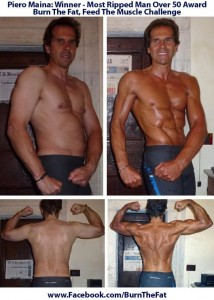Titolo: Burn The Fat Summer Challenge 2012….La Mia Esperienza.
Autore:Piero Maina
Conteggio Parole: 2884
Ed eccoci qui, per il terzo anno consecutivo ho concluso la “Burn The Fat Summer Challenge” la sfida di trasformazione corporea della durata di 14 settimane o 98 giorni che vede premiate le persone che ottengono la migliore trasformazione corporea nel suddetto periodo di tempo. Quindi, a meno che non si tratti di una categoria specifica, il vincitore assoluto, non sarà necessariamente quello che avrà perso più peso o il più magro o il più muscoloso, ma quello che oggettivamente avrà cambiato la sua forma fisica in meglio, perdendo la quantità maggiore di grasso, conservando o addirittura aumentando la massa muscolare/massa magra, senza aiuto di steroidi/anabolizzanti, solamente attraverso l’alimentazione e l’esercizio fisico.

“Most Ripped Man Over 50”
Clicca sull’immagine per ingrandirla
Quest’anno il mio impegno è stato massimo e alla fine sono stato premiato come la muscolatura più definita fra gli uomini concorrenti oltre i 50 anni di età (Most Ripped Man Over 50. Cliccate qui per la mia intervista sul sito Burn The fat in Inglese ), e questo comunque non in valore assoluto, ma sempre come conseguenza della migliore trasformazione corporea. Il risultato va confrontato con le condizioni iniziali, infatti un altro concorrente potrebbe anche essere più definito del sottoscritto, ma bisogna confrontare la condizione di partenza e le eventuali limitazioni fisiche a cui uno potrebbe essere soggetto. Se prendiamo il vincitore assoluto, oggi quarantunenne, che è stato premiato con un viaggio di 7 giorni alle isole Hawaii per due persone all-inclusive (lo stesso per la prima assoluta delle donne), la sua condizione iniziale era quella di un semi obeso, che in soli 98 giorni si è trasformato in un fisico asciutto e massiccio. Vorrei spiegare che il soggetto in questione quando aveva 18/20 anni giocava a football americano e faceva gli squat con 150 kg. sulle spalle e quindi i muscoli li aveva già costruiti allora. Quando vedete le trasformazioni (compresa la mia), non è che i muscoli che vedete sono il frutto di un allenamento della durata di 98 giorni, ma almeno nel mio caso, il risultato di una vita di allenamento (anche se negli ultimi 18 anni i pesi per i miei problemi di salute, non li ho più potuti utilizzare qui l’articolo che spiega il perchè). Certamente durante i 98 giorni di durata della sfida/gara, i muscoli sono stati allenati al massimo e complice anche l’alimentazione hanno ripreso vigore o sono anche aumentati. Ricordate che senza aiuti “chimici” ottenere masse enormi partendo da un fisico da “scartatore di caramelle” in 98 giorni diciamo che è impossibile. Ci sono poi individui geneticamente superdotati o i principianti della palestra che allenandosi e alimentandosi correttamente otterranno risultati molto superiori alla media, ma mai da tisico a culturista. Tornando al nostro vincitore assoluto, dopo i trascorsi da sportivo in gioventù e dopo 20 anni di matrimonio, tre figli e la vita sedentaria da poliziotto e un’alimentazione non proprio ottimale, ha visto lievitare il suo peso e la sua circonferenza a livello della vita. A suo dire era il re dei ciambelloni e dolciumi vari. Fino a quando ha preso la decisione concreta nella sua mente di cambiare, mettendo in pratica gli insegnamenti presenti nel libro/programma “BurnTheFat Feed The Muscle” e utilizzando la Summer Challenge come motivazione per riuscire, il risultato si è realizzato e ha potuto regalarsi e regalare a sua moglie, il viaggio di nozze che 20 anni prima si erano negati per problemi economici. Certamente con circa 3.000 iscritti e tutte persone motivate, che hanno comperato il libro e che quindi conoscono le istruzioni per riuscire, non è semplice primeggiare e poi le situazioni di partenza sono profondamente diverse e anche per i giudici è come comparare mele con pere, viste le differenze fisiche e di età. Va detto che ogni anno di questi quasi 3.000 partecipanti, che all’inizio sono tutti desiderosi di primeggiare e scrivono affermazioni piuttosto presuntuose ed audaci nei propri giornali all’interno del forum di gara , solamente trecento persone circa riescono a portare al termine la sfida e gli altri perdono il treno o come dicono gli americani “They fall off the wagon”. Dei circa trecento, direi che un centinaio hanno postato le loro statistiche, foto iniziali e finali e hanno sempre aggiornato il loro giornale, ma a mio parere le differenze fra le foto iniziali e quelle finali, non recano sostanziali cambiamenti. Quindi direi che alla fine sono solo 150 i veri finalisti, quelli che sono visibilmente cambiati, e sono solo il 5% dei partecipanti. Ci vuole molta volontà e disciplina per avere successo, oltre ad una organizzazione maniacale per riuscire a mangiare i 5/6 pasti giornalieri in tutte le situazioni che la vita quotidiana ci presenterà e che siano oltretutto composti da cibi giusti, nelle giuste quantità e con i macronutrienti correttamente bilanciati. Non è che uno può mangiare ciò che vuole, certo come ho già detto sopra, ci sono eccezioni per somatotipi mesomorfi, ma mediamente e anche per loro, per raggiungere il miglior risultato è necessario mangiare al meglio. Non si può ottenere il massimo se non si va oltre il massimo. Il primo premio è il viaggio, poi esistono premi di categoria, ma non sono paragonabili al viaggio. Si va dall’iPod all’ iPad al kindle al libro firmato da Tom Venuto e i premi a disposizione non sono molti, ma vorrei far capire che già l’aver terminato la sfida è il premio più grosso. Se uno riesce nell’intento impegnandosi al massimo si ritroverà nella miglior forma fisica della sua vita e questa oltre ad essere una grande soddisfazione è realmente il premio più importante che lo/la consacrerà come vincente o come dicono gli americani come un/una “achiever”.
Come ho già spiegato nell’ articolo Burn The Fat….La mia esperienza , sono arrivato alla mia attuale forma fisica grazie agli insegnamenti contenuti nel libro scritto da Tom Venuto (BurnTheFat Feed The Muscle ) e nonostante gli infortuni e il non potermi allenare come avrei voluto per 18 anni, posso tranquillamente affermare che è oggi che ho raggiunto il mio stato di forma migliore, oggi che ho 51 anni e il viaggio è appena cominciato. Conto di migliorare ancora e per questo ringrazio, invece di provare amarezza e frustrazione per non averne goduto prima o per essere incappato nell’infortunio della trombosi alla vena succlavia/ascellare, oltre ad altri vari incidenti più o meno gravi che hanno accompagnato la mia esistenza e questo modello di pensiero è sicuramente un valido alleato per il raggiungimento degli obiettivi che ci siamo prefissati in generale nella vita.
Quest’anno la sfida è stata vinta grazie ad una profonda motivazione, disciplina, responsabilità, impegno, dedizione e desiderio di riuscire, focalizzando solamente l’obiettivo. Il risultato ottenuto è una sinergia di quattro elementi: La mente che ha preso una decisione, l’alimentazione che dovrà essere “pulita”, l’allenamento contro resistenza/pesi e l’allenamento cardio per bruciare più calorie e quindi perdere maggior quantità di grasso. Tutti questi quattro elementi sono necessari per la riuscita e uno non è meno importante dell’altro, ma presi singolarmente non hanno la stessa valenza esponenziale rispetto a quando vengono utilizzati in sinergia. La somma dei quattro non darà come risultato quattro, ma dieci, cento, mille. C’è anche il quinto elemento: il supporto psicologico. Sia che provenga da un preparatore che da un amico o nel caso specifico dal Burn the fat inner circle, l’avere un gruppo di persone che ti sostenga motivandoti e consigliandoti nei momenti di crisi o quando si raggiunge la soglia del “plateau” è forse l’elemento determinante per la riuscita e il raggiungimento dell’obiettivo. Alzarsi tutte le mattine molto presto per effettuare l’allenamento cardio (corsa,bici,nuoto,etc.) o l’allenamento contro resistenza/pesi richiede una profonda motivazione. Anche gli infortuni mi hanno fatto compagnia nuovamente, non come l’anno scorso che avevo avuto una brutta distorsione alla caviglia oltre alla rottura di due costole e avevo continuato ad allenarmi nonostante i dolori. Inoltre pur vivendo in albergo a Milano e facendo la spola con Roma e mangiando sempre al ristorante o in macchina ero arrivato al 5,89% di massa grassa con un ottimo stato di forma, pur non facendo parte dei 10 finalisti uomini. Anche due anni fa mi sono infortunato, con la frattura da stress alla tibia destra (per fortuna l’ho avuta nell’ultima settimana di gara, ma mi ha accompagnato per i sei mesi successivi impedendomi qualsiasi attività che impegnasse le gambe, ma il resto del corpo è stato allenato regolarmente). Quest’anno il Neuroma di Morton nel piede destro si è risvegliato e mi ha impedito di correre come avrei voluto, nonostante ciò ho continuato lo stesso le sedute di allenamento con posture non proprio corrette e oltre al piede avevo (ed ho ancora), una brutta epicondilite al gomito destro che non mi faceva alzare nemmeno una bottiglia senza provare dolore. Quando proprio era diventato impossibile allenarsi, ho dovuto ricorrere alle infiltrazioni di cortisone. Oltre ai problemi fisici c’era il problema logistico, visto che sono rimasto lontano da casa con la famiglia per un lungo periodo e organizzarsi per mangiare 6 volte al giorno e soprattutto non cedere alle tentazioni, quando al villaggio turistico al buffet c’era ogni ben di Dio e in più con la famiglia che non mi supportava nelle mie scelte, è stata una sfida nella sfida.
Ognuno di noi ha situazioni differenti, di metabolismo, risposte ormonali, genetica, costituzione,volontà, stili di vita, situazioni lavorative, economiche, etc. Ognuno di noi da valori ed importanza diverse a ciascuna di queste problematiche e le affronta in maniera diversa. Va detto inoltre che non esiste nè un piano alimentare che vada bene per tutti, nè una soluzione univoca, ma alla base c’è una decisione, una scelta di un individuo che decide raggiungere un obiettivo, uno scopo che a seconda di quanto quell’obiettivo sarà importante nella sua mente, sarà raggiunto. Può anche darsi che l’obiettivo finale sia troppo ambizioso e non possa essere raggiunto nelle 14 settimane a disposizione, l’importante e che noi cominciamo a muoverci verso tale obiettivo e nel tempo a nostra disposizione facendo del nostro meglio. Alla fine del periodo in questione, sia che lo avremo raggiunto, sia che non saremo riusciti, rinnoveremo il nostro nuovo obiettivo con uno più ambizioso o posticiperemo il vecchio finché non sarà stato raggiunto. Ma non saremo delusi per il mancato raggiungimento assumendo la cosa come un fallimento. Non esistono fallimenti, ma solo risultati. Guardando i nostri risultati senza perdere di vista i nostri obiettivi, saremo in grado di portare le dovute correzioni per proseguire il “viaggio”, ma non rinunceremo scoraggiati perchè abbiamo fallito. Questa è la differenza fra chi riesce e chi rinuncia. E non fatevi fuorviare dai comuni “perdenti” che troverete sul vostro cammino che faranno di tutto per farvi diventare “realisti” e vi diranno che non serve a nulla se per raggiungere il vostro obiettivo dovrete forse impiegare 10 anni o più e magari sarete già vecchi. Qui dovrei divagare parlandovi di come viene vissuto il tempo, soprattutto da parte mia, ma entrerei in discorsi di metafisica troppo complicati e andremmo fuori tema. Vi invito comunque a cercare di visualizzare dove vorreste essere, (in questo caso a livello di forma fisica, ma il discorso vale veramente per tutto il resto nella vita) e proviate a muovervi verso quel risultato, accettando tutti i passaggi, anche molto difficili che incontrerete, fino a che sarete arrivati a destinazione.
Chiudo inserendo le foto iniziali e finali della Summer Challenge 2012. Metto quelle laterali e di schiena che sono state pubblicate sul sito http://www.burnthefatinnercircle.com e poi ho fatto un collage con le foto di schiena delle tre Summer Challenge dal 2010 al 2012 così che possiate notare le differenze nei tre anni in esame.

Trasformazione ottenuta in 98 giorni
Cliccate per ingrandire
Per chi parla Inglese,queste le parole che Tom Venuto ha scritto sul suo profilo facebook riguardanti il mio premio/risultato:
More Amazing Body Transformations! This year, the Burn the Fat Challenge had more competition for the “most ripped” title and “most transformed over 50” than ever, so, we created a new award… Introducing, Piero Maina of Italy – The “Most Ripped Man Over 50! Click LIKE if you think is incredible for age 51 (or any age!)… like something Michelangelo carved out! 🙂
E ancora aggiungo, sempre in Inglese le motivazioni per la nomination al mio premio, che è stato istituito dopo la nomina dei 10 finalisti uomini, (dove ancora una volta non ero presente) e del vincitore per la miglior trasformazione uomini over 50. Il vincitore di quella categoria a cui anche io aspiravo è stato un uomo di 56 anni con diversi problemi di salute che da uno stato di obesità molto marcata ha trasformato drasticamente il suo fisico (non è minimamente definito come me, ma ha perso un’enorme quantità di grasso e ha eliminato un addome da donna incinta decadente quasi completamente in 98 giorni e meritava quindi e giustamente il premio). Qui sotto le parole dell’annuncio di Tom Venuto sul forum di Burn The Fat Inner circle:
RE: 2012 SUMMER CHALLENGE AWARDS ANNOUNCEMENT THREADPosted Wednesday, September 26, 2012 at 11:51 PM
SPECIAL AWARD ANNOUNCEMENT
This was our 6th season of the burn the fat challengeDuring the judging process, in many of our contests of the past, and especially in this one, we noticed one or more faces / names (bodies) popping up more than once during the voting for potential nominees or finalists. Sometimes a person pops up MULTIPLE TIMES, with multiple nominations.That’s exactly what happened here, during the judging for the 2012 summer challenge, for one man.When the first round of individual contest finalist nominations came in, (narrowing the entire field down to potential finalists or standouts, his name was there. When the second round came in (narrowing down to smaller list of potential top 10), his name was there again.Then, when the most ripped competition came around, his name was in the nominations again. That was the third time we saw him. (he was ripped!)And, when the most transformed over 50 round nominations came in, guess who’s name showed up yet again? Yep same guy, He just turned 51.So why haven’t we seen him in the list before? Well, the top 10 were not only extremely close and difficult to judge in general, it was filled with men of different body shapes and totally different starting and ending points. The judges narrowed it down by personal improvement from start to finish and it was no easy task comparing the amount of improvement from a man of one body type and starting point to a man of another. Many of the men in the 11th, 12th, 13th, etc spots were all phenomenal. It was just a close contest.The most ripped award. That was an amazing turnout of potential nomiinees, but we had an amazing overall champion there who won that award unanimously. But, the guys in 2nd 3rd, 4th, 5th, etc were also PHENOMENAL.Same thing for most transformed over 50 category. picking a winner was tough and there were MANY nominations for that category. We dont think we’ve ever seen so many fantastic over 50 burners.So after the “regular” awards were given, we simply couldnt stop thinking about some of these men who were so close to the top. But one in particular was so close in every category, we simply KNEW we had to give him some serious kudos. We have done it before in many of our contests, and we are pleased to announce that we are doing it again. We have created a new special category, just for this challenge because of a unique achievement.
THE MOST RIPPED MAN OVER 50
And the recipient of this award is Piero Maina!
Piero, your achievements display improvements across multiple categories – in fact, we could probably say your results also embody a “most inspirational” element because of what you’ve had to work through and overcome to achieve this.
You deserve the recognition and the prizes that come with a special category award. Congratulations!
Devo aggiungere due righe per chi eventualmente dopo avere visto le immagini possa pensare che i risultati raggiunti siano stati ottenuti con l’aiuto di sostanze anabolizzanti, come anche qualche mio amico scherzosamente, ma non troppo , ha detto. Faccio presente che se realmente avessi usato steroidi, le mie masse muscolari sarebbero aumentate notevolmente e questo non è successo. E’ nei miei piani di aumentare di massa magra/muscolo di almeno 6/8 kg. ma perchè questo accada, utilizzando metodi naturali devo allenarmi e mangiare in un certo modo e sarà necessaria una certa quantità di tempo più o meno lunga. Va da se che per aumentare di massa io debba mangiare di più di quello che consumo, ma è ovvio che possa aumentare anche di grasso, cosa che molti bodybuilder fanno nel periodo lontano dalle gare per poi “tirarsi” nelle 12/14 settimane pre gara cercando di mantenere quanto più possibile il muscolo “guadagnato” durante la fase di “bulk”…esistono poi differenti metodi di carico/scarico dei carboidrati,ma questa è un’altra storia. Quindi tornando a me l’effetto della riduzione drastica del grasso e degli allenamenti di forza e cardio fanno sembrare le cose come non sono.

Cliccate sull’immagine per ingradirla
Spero che attraverso questo articolo le persone che credono di voler/dover apportare dei cambiamenti sia a livello fisico che in generale nella propria vita, trovino una valida motivazione sapendo che realmente gli unici limiti sono molto spesso solo ed esclusivamente nella propria mente. Fate un piccolo passo in avanti e “volate”.
© Copyright Piero Maina – Tutti i diritti riservati



















